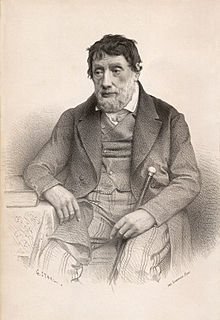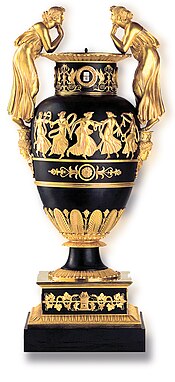Louis Moinet
Louis Moinet (* 1768 in Bourges ; † May 21, 1853 in Paris ) is the inventor of the chronograph .
Life
At the age of 20, Moinet left France for Rome, where he studied architecture , sculpture and painting for five years . Here he met the members of the Académie de France , the greatest artists of their time. From Rome he went on to Florence . In a workshop made available by Count Manfredini, Minister of the Grand Duke of Tuscany , he familiarized himself with the art of engraving on semi-precious stones. He also created several paintings.
On his return to Paris he was appointed professor at the Academy of Fine Arts in the Louvre . He joined several scientific and artistic societies and worked with well-known personalities such as the astronomer Lalande , the bronze artist Thomire and the skillful automaton maker Robert-Houdin , who is regarded as the "innovator of magic".
At the same time he studied the theory and practice of watchmaking. From 1800 onwards, watchmaking took up all of his time. During long stays in Switzerland between the Jura Mountains and the Joux Valley, he met famous watchmakers - including Jacques-Frédéric Houriet - and acquired his watchmaking instruments and tools.
Louis Moinet was appointed chairman of the Société Chronométrique de Paris - Paris Society for Chronometry - which set itself the task of “developing and promoting watchmaking”, “one of the most beautiful sciences of the human mind”. In this context he maintained frequent contacts with colleagues: Louis Berthoud, Antide Janvier, Louis-Frédéric Perrelet, Joseph Winnerl and Vulliamy, the King's watchmaker in London.
plant
Louis Moinet worked closely with Abraham Louis Breguet for many years , was a close friend, confidante and intimate advisor to him. The two men shared the same passion for watchmaking.
In his life Moinet created pendulum clocks for important personalities of his time: Napoleon Bonaparte , the American Presidents Thomas Jefferson and James Monroe , King George IV , Ernest Augustus, Prince of Hanover, Queen Maria Amalia of Naples-Sicily |, Marshal Joachim Murat , Marshal Michel Ney and other crowned heads in Europe.
Napoleon's pendulum clock was made in 1806. It has an eight-day clockwork and displays the hour, minute and date. What makes it special is a remarkable clockwork that uses a tiny ivory ball on the day hand to indicate the phase of the moon . In addition, the coronation of Napoleon and Empress Joséphine is always started when the music box is running . An automatic mechanism places the imperial crown on their heads.
The clocks can be found today in museums such as the Louvre in Paris, the Palace of Versailles , the Palazzo Pitti in Florence or in the Monticello and the White House .
Inventions
As a manufacturer of precision instruments, Louis Moinet dealt with marine clocks as well as astronomy clocks and civil clocks. He became the author of several important improvements. Most important is his "Compteur de Tierces" ("Terzzähler"), created in 1816, which made Louis Moinet the inventor of the chronograph. This instrument measures sixtieth of a second, produces 216,000 vibrations per hour and has a zero reset.
Louis Moinet's products have been shown at two world exhibitions. The first time in 1851 in London . Here Louis Moinet presented a chronometer with an annual calendar and weekday display. Then in Paris in 1900 . Napoleon's pendulum clock was shown at this exhibition.
Louis Moinet's work also includes alarm clocks, regulators and astronomical clocks. These include pocket watch calibers with a specific distribution (an entire clockwork mechanism made up of a drive with 12 teeth). A spring with a toothed barrel is also one of his inventions. He explains that this nib was “the color of a half-ripe red cherry” when it was processed in the oven. He also invented a new balance cock for easier winding. He designed a construction that would set the spiral block in motion to balance the escapement without the slightest dismantling. He split, rounded and finished the gear train of his marine watches by hand according to the calculation formulas explained in his watchmaking textbook “Traité d'Horlogerie”.
The famous watchmaker's textbook ("Traité d'horlogerie")
Louis Moinet is best known for his famous textbook “Traité d'Horlogerie”, published in 1848, which describes watchmaking techniques. It was reprinted three times and was distributed as far as Russia. Moinet dedicated twenty years of his life to composing this work in two volumes.
| personal data | |
|---|---|
| SURNAME | Moinet, Louis |
| BRIEF DESCRIPTION | French watchmaker |
| DATE OF BIRTH | 1768 |
| PLACE OF BIRTH | Bourges , France |
| DATE OF DEATH | May 21, 1853 |
| Place of death | Paris , France |






